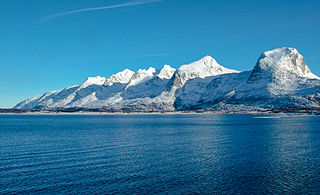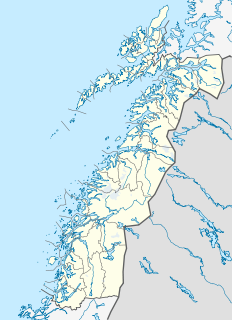
Nordland is a county in Norway in the Northern Norway region, bordering Troms og Finnmark in the north, Trøndelag in the south, Norrbotten County in Sweden to the east, Västerbotten County to the southeast, and the Atlantic Ocean to the west. The county was formerly known as Nordlandene amt. The county administration is in Bodø. The remote Arctic island of Jan Mayen has been administered from Nordland since 1995.

Bindal is a municipality in the Helgeland region in the extreme southwest part of Nordland county, Norway. The administrative centre is the village of Terråk. Other villages include Bindalseidet, Holm, Vassås, Horsfjord and Åbygda.

Nesna is a municipality in Nordland county, Norway. It is part of the Helgeland traditional region. The administrative centre of the municipality is the village of Nesna. Other villages in Nesna include Handnesneset, Husby, Saura, and Vikholmen.
Bø may refer to the following:

Sheikhpura district is one of the thirty eight districts of Bihar state, India, and Sheikhpura town is the administrative headquarter of this district. Sheikhpura district is a part of Munger Division. Sheikhpura was separated from Munger District and was made a separate district with headquarter at Sheikhpura on 31 July 1994. As of 2011 it is the least populous district of Bihar.

Drevvatnet is a lake that lies in the municipality of Vefsn in Nordland county, Norway. The village of Drevvassbygda lies at the northeastern end of the 4.93-square-kilometre (1.90 sq mi) lake, in the Drevjedalen valley. The Nordland Line railway follows the southern coast of the lake.

Fjærvatnet or Indre Fjærvatn is a lake that lies in the municipality of Bodø in Nordland county, Norway. The 2.48-square-kilometre (0.96 sq mi) lake is located about 3 kilometres (1.9 mi) south of the village of Kjerringøy, near the village of Fjære.

Krutvatnet (Norwegian) or Kruvhtegenjaevrie (Southern Sami) is a lake in the municipality of Hattfjelldal in Nordland county, Norway. It lies about 7.5 kilometres (4.7 mi) east of the lake Røssvatnet and about 2 kilometres (1.2 mi) west of the border with Sweden. The Norwegian National Road 73 runs on the southern shore of the lake on its way from the village of Hattfjelldal to the village of Tärnaby in Sweden.

Majavatnet (Norwegian) or Maajehjaevrie (Southern Sami) is a lake in the municipality of Grane in Nordland county, Norway. The 16.6-square-kilometre (6.4 sq mi) lake lies just west of Børgefjell National Park in southern Grane. The village of Majavatn lies on the eastern shore of the lake. European route E06 and the Nordland Line both run along the eastern shore of the lake.

Ramsgjelvatnet is a lake that lies in the municipality of Beiarn in Nordland county, Norway. The lake is located about 5 kilometres (3.1 mi) northeast of the village of Høyforsmoen and about 15 kilometres (9.3 mi) southeast of the village of Moldjord.

Sausvatnet is a lake that is located in Brønnøy Municipality in Nordland county, Norway. There is also a small village on the eastern shore called Sausvatn. The lake is located about 7 kilometres (4.3 mi) south of the village of Hommelstø and about 15 kilometres (9.3 mi) northwest of the village of Lande.

Storvatnet (Norwegian) or Ránujávri (Northern Sami) is a lake in Narvik Municipality in Nordland county, Norway. The 9.76-square-kilometre (3.77 sq mi) lake is located about 8 kilometres (5.0 mi) east of the village of Ballangen.

Reine is the administrative centre of Moskenes Municipality in Nordland county, Norway. The fishing village is located on the island of Moskenesøya in the Lofoten archipelago, above the Arctic Circle, about 300 kilometres (190 mi) southwest of the town of Tromsø. Reine Church is located here and it serves the northern part of the municipality.

Barbigha is a city and a municipality in the Sheikhpura district of Bihar, India. It is well connected by road to the state capital of Patna. National highways NH82 and NH333A also pass through Barbigha, and Bihta-Sarmera four lane state highway passes from Gopalbad near it.

The Sulitjelma Line was a railway line that ran between Finneid in the town of Fauske to the village of Sulitjelma near the border with Sweden. The railway line was entirely inside the municipality of Fauske in Nordland county, Norway. The line was built in 1891, over time it was lengthened until 1958 when it was connected to the Nordland Line and the sea port at Finneid. It existed as a branch of the Nordland Line from 1958 until 1972 when the line was closed and removed. The railway line followed the path of the present-day Norwegian County Road 830.

Lieven Mehus or Livio Mehus was a Flemish painter, draughtsman and engraver of the Baroque period, who trained and worked in Italy. He was mainly active in Florence where he was court painter of Prince Mattias de' Medici. During his lifetime he enjoyed a high reputation for his allegorical and mythological scenes, landscapes, religious works and portraits.
Mehus is a last name common to Flemish and Norwegian people. In the United States of America it is most common in North Dakota.

Manuiyeh is a village in Dashtab Rural District, in the Central District of Baft County, Kerman Province, Iran. At the 2006 census, its existence was noted, but its population was not reported.
Mehu was an Ancient Egyptian vizier who lived in the Sixth Dynasty, around 2300 BC. The office of the vizier was the most important one at the royal court. Mehu is mainly known from his monumental mastaba at Saqqara, not far away from the Pyramid of Unas. The exact dating of Mehu is disputed in Egyptology. Hartwig Altenmüller published the relief decoration of the mastaba and dates him under king Teti. He argues that the one of the brothers of Mehu with the name Iynefret is identical to another vizier also named Iynefret, who might date to the early Sixth Dynasty. Furthermore, Mehu carried the title of an overseer of priest at Djed-sut-Teti, that is the pyramid complex of king Teti. Other argue that he dates slightly later under king Pepy I. Not much is known about Mehu's family. The parents are unknown. He has two wives, one called Nebet, the other one Neferkaus. Mehu was bearing a high number of important titles. These include the titles of the vizier, but he was also Overseer of the treasuries, overseer of the double granary, overseer of Upper Egypt and overseer of all royal works. Several sons are mentioned in the tomb. One son was perhaps called Mery, but his name was several times deleted. Another son was Hetepka. Within the mastaba of Mehu there are parts reserved for a vizier called Hetepka. It is possible that he was the son of Mehu, albeit final evidence for this identification is missing. The vizier Hetepka might have been just a member of Mehu's family. Two other known children of Mehu are a daughter called Merut and a further son called Khuy.












